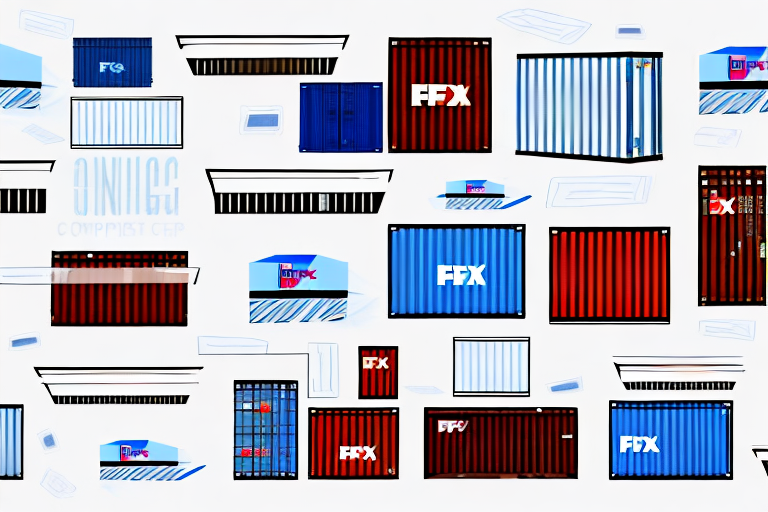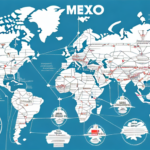Comparing International Shipping Rates: UPS vs. FedEx
When it comes to international shipping, two major players dominate the market: UPS and FedEx. Both companies offer reliable and efficient services to customers worldwide. If you're looking to ship internationally and wondering which carrier to choose, understanding the key differences between the two is crucial. In this article, we'll delve into the history, rates, services, and customer reviews of both UPS and FedEx to help you make an informed decision.
Introduction to International Shipping
International shipping involves transporting goods from one country to another, necessitating additional documentation, customs clearance, and adherence to various fees and taxes. Partnering with a reliable and experienced carrier ensures that your packages are delivered on time and in excellent condition.
When shipping internationally, it's essential to consider the differing regulations and restrictions that may apply to certain products. For example, some countries restrict the import of specific foods, plants, or electronics. Thorough research and compliance with these regulations can prevent delays or issues with customs. Additionally, purchasing insurance for your shipments is recommended to protect against potential damage or loss during transit.
Brief History of UPS and FedEx
UPS (United Parcel Service) was founded in 1907 as a messenger company in Seattle, Washington. Over the years, UPS has expanded into a global logistics powerhouse, serving customers in over 220 countries and territories. According to their [2023 Annual Report](https://investors.ups.com/annual-reports), UPS generated approximately $100 billion in revenue, emphasizing their extensive global reach.
FedEx, founded in 1971, initially focused on overnight delivery services. Today, FedEx has also evolved into a global logistics provider, with a presence in over 220 countries and territories. FedEx reported revenues of around $90 billion in 2023, highlighting their strong position in the logistics industry.
Despite their similar global reach, UPS and FedEx adopt different business models. UPS has traditionally emphasized ground transportation, maintaining a large fleet of brown delivery trucks. In contrast, FedEx has a robust focus on air transportation, operating its own fleet of planes. This strategic difference allows both companies to carve out unique niches within the logistics sector, offering distinct services to their customers.
Basic Differences between UPS and FedEx
Several key differences set UPS and FedEx apart:
- Delivery Networks: UPS boasts a larger fleet of planes and trucks, enabling faster and more comprehensive distribution. FedEx specializes in overnight and express delivery services, making it ideal for urgent shipments.
- Pricing Structure: UPS generally offers more affordable rates for standard ground shipping, while FedEx's rates are typically higher but provide more expedited shipping options.
- Service Range: UPS offers a broader range of services, including freight shipping and complex logistics solutions. Conversely, FedEx primarily focuses on package delivery.
Comparison of International Shipping Rates
Shipping rates are a critical factor when choosing a carrier for international shipments. Both UPS and FedEx provide a variety of shipping options tailored to different needs and budgets, but there are notable differences in their pricing structures.
UPS offers a wide range of shipping options, including ground, air, and ocean freight. Their rates are generally lower for ground and ocean shipping, making them a cost-effective choice for non-urgent shipments. According to [UPS Pricing](https://www.ups.com/us/en/shipping/international.page), ocean freight can be up to 30% cheaper than air freight for heavy shipments.
FedEx specializes in express shipping, which tends to be more expensive but ensures faster delivery times. For instance, FedEx International Priority offers delivery in 1-3 business days, whereas UPS Worldwide Express typically delivers within 1-3 business days as well.
Both carriers provide discounts for frequent shippers and bulk shipments, which can significantly reduce costs for businesses that regularly ship internationally. Additionally, online tools and calculators offered by both UPS and FedEx help customers estimate shipping costs and compare rates across different shipping options.
It's also important to consider destination-specific factors, such as import taxes and fees, which can vary by country and impact the total shipping cost. Researching these fees beforehand ensures a more accurate comparison of overall expenses.
Factors that Affect International Shipping Rates
Several factors influence the cost of international shipping:
- Package Weight and Dimensions: Heavier and larger packages incur higher shipping costs.
- Destination: Shipping to remote or less accessible countries may attract additional fees.
- Shipping Speed: Faster shipping options, such as express or overnight services, typically cost more.
- Additional Services: Services like insurance, customs clearance, and special handling can increase the overall cost.
Both UPS and FedEx offer online calculators that consider these factors to provide accurate shipping rate estimates. Ensuring precise package information during calculation is essential for obtaining reliable quotes.
The type of goods being shipped also affects shipping rates. Items classified as hazardous or restricted may require additional documentation and incur extra fees. It's crucial to verify with the carrier and consult the destination country's customs regulations before shipping such items.
Seasonal demand can also influence shipping rates. During peak periods like holidays, carriers may adjust their rates due to increased demand. Planning shipments in advance can help avoid potential rate hikes and ensure timely delivery.
How to Calculate International Shipping Rates
Calculating international shipping rates involves several steps:
- Measure Package Weight and Dimensions: Accurate measurements are essential for precise rate estimates.
- Determine Destination Country and Postal Code: Rates vary based on destination.
- Choose Shipping Speed and Service Level: Decide between standard, express, or overnight services based on urgency.
- Select Additional Services: Options like insurance or customs clearance can affect the cost.
- Use Carrier's Online Calculator: Both UPS and FedEx provide tools to estimate shipping costs.
Remember that these rates are estimates and may fluctuate based on actual package weight, dimensions, and unforeseen fees or taxes during transit.
The nature of the product being shipped also plays a role. Certain items, such as electronics or food products, might face restrictions or require additional documentation, leading to higher costs.
Researching the carrier's reputation and reliability in delivering to the specific destination country is also vital. Carriers may have varying success rates and delivery speeds across different regions, impacting both cost and reliability.
Advantages of Using UPS for International Shipping
UPS offers several advantages for international shipping:
- Wide range of shipping options, including ground, air, and ocean freight.
- Lower rates for ground and ocean shipping compared to air freight.
- Extensive global delivery network covering over 220 countries and territories.
- Comprehensive customs clearance services to facilitate smooth international shipments.
Additionally, UPS provides advanced tracking and monitoring systems, allowing customers to track their shipments in real-time. Flexible pickup and delivery options, including weekend and after-hours services, offer added convenience.
UPS is also committed to sustainability, offering eco-friendly shipping options such as carbon-neutral shipping and utilizing alternative fuels in their delivery vehicles.
Advantages of Using FedEx for International Shipping
FedEx presents several benefits for international shipping:
- Specialization in express and overnight delivery services, ensuring fast delivery times.
- Reliable and consistent service with a strong focus on speed and efficiency.
- Flexible delivery options, including Saturday deliveries and specific delivery windows.
- Global distribution network that ensures wide coverage and accessibility.
FedEx also offers comprehensive customs clearance services, simplifying the process of navigating complex international regulations. Detailed tracking information allows customers to monitor their shipments throughout the delivery process, enhancing transparency and reliability.
Comparison of Services Offered by UPS and FedEx for International Shipping
Both UPS and FedEx provide a suite of similar services for international shipping, including:
- Air and ocean freight options.
- Customs clearance assistance.
- Insurance options to protect shipments.
- Tracking and delivery confirmation services.
However, there are distinct differences in how each carrier approaches these services:
- Guaranteed Delivery Times: UPS offers guaranteed delivery times for select shipments, providing assurance to customers about delivery schedules.
- Flexible Delivery Options: FedEx allows customers to choose specific delivery windows, offering greater flexibility for receiving shipments.
Another key difference lies in package pickup services. UPS provides scheduled pickups, allowing customers to arrange for a driver to collect packages at a designated time. In contrast, FedEx offers on-demand pickups, enabling customers to request package collection at any time, including the same day. This flexibility is particularly beneficial for businesses with fluctuating shipping volumes or last-minute shipment needs.
Additional Fees for International Shipping with UPS and FedEx
When shipping internationally with UPS or FedEx, additional fees may apply, including:
- Customs duties and taxes based on the destination country's regulations.
- Customs brokerage fees for handling the customs clearance process.
- Fuel surcharges that fluctuate with fuel prices.
- Remote area surcharges for deliveries to less accessible locations.
Being aware of these additional fees is essential to avoid unexpected costs when shipping internationally.
Both UPS and FedEx may also charge handling fees for shipments requiring special attention, such as hazardous materials or oversized packages. It's important to review the carriers' fee structures and factor these into your shipping budget.
Delivery times can vary based on the destination country and any necessary customs clearance procedures. While UPS and FedEx offer reliable international shipping options, it's crucial to account for potential delays when planning your shipments to ensure timely delivery.
Customer Reviews of UPS vs. FedEx for International Shipping
Customer reviews provide valuable insights into the performance of UPS and FedEx for international shipping. Generally, both carriers receive positive feedback for their reliability and global reach. However, some customers have reported issues such as delayed or lost packages and unexpected fees and taxes.
Cost: The cost-effectiveness of UPS versus FedEx varies depending on factors like destination, package weight, and shipping speed. Some customers find UPS more affordable for standard shipments, while others perceive FedEx as pricier but worth the faster delivery times.
Customer Service: Customer service experiences differ between the two carriers. Some customers praise UPS for having more responsive and helpful representatives, while others commend FedEx for efficient and streamlined customer support.
It's advisable to consider multiple customer reviews and ratings to gauge which carrier aligns best with your specific international shipping needs.
Tips for Choosing the Best Carrier for Your International Shipping Needs
To select the optimal carrier for your international shipping requirements, consider the following tips:
- Determine Budget and Shipping Needs: Assess your budget constraints and the specific requirements of your shipments, such as speed and destination.
- Compare Rates and Services: Evaluate the shipping rates and services offered by both UPS and FedEx to identify the best fit for your needs.
- Check Customer Reviews and Ratings: Research feedback from other customers to understand the strengths and weaknesses of each carrier.
- Consider Additional Fees and Taxes: Factor in any potential extra costs, such as customs duties and handling fees, when comparing carriers.
- Choose a Carrier with a Reliable Network: Opt for a carrier that offers a comprehensive and dependable global delivery network to ensure timely and secure deliveries.
Conclusion: Which Carrier is the Best Option for Your Business?
Ultimately, the best carrier for your business depends on your specific needs and budget. UPS provides a wider range of shipping options at competitive rates, making it a cost-effective choice for businesses prioritizing affordability and extensive service offerings. On the other hand, FedEx excels in express and overnight shipping services, making it ideal for businesses that require fast and reliable delivery times.
Both carriers offer reliable service and expansive global networks. By carefully evaluating your shipping needs, comparing the rates and services of UPS and FedEx, and considering customer reviews, you can make an informed decision that best supports your business operations.






















